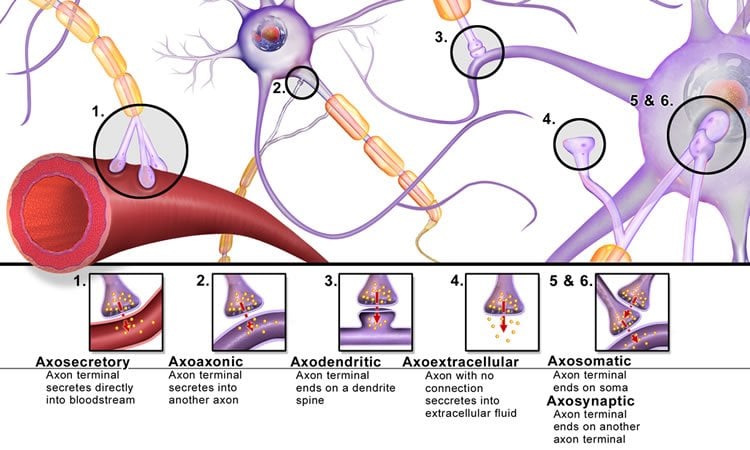Genetic analysis of human patients has shown that mutations in genes involved in synaptic communication can drive neuropsychiatric and neurological diseases such as autism spectrum disorder and Alzheimer’s disease. Through a global analysis of the synaptic machinery Jeffrey Savas (Northwestern University Feinberg School of Medicine) and Joris de Wit (VIB/KU Leuven) together with their colleagues revealed for the first time a new pathway that governs the proper sorting of many essential synaptic proteins in neurons. Disruption of this sorting pathway in neuropsychiatric and neurological diseases severely hampers the efficient communication between neurons.
Joris de Wit (VIB/KU Leuven): “Our results suggest that therapeutic targeting of this pathway may prove efficacious in treating multiple neurological diseases. Jeff and I started this work in the US, when Jeff was a postdoc with John R. Yates III at The Scripps Research Institute and I was a postdoc with Anirvan Ghosh at the University of California San Diego. We continued this work after we both established our own labs, with the help of Luís Ribeiro here at VIB/KU Leuven.
“This intense international collaboration has enabled us to use cutting-edge proteomic technology to study the entire synaptic machinery rather than individual elements.” Said Joris de Wit.
Our work identifies a master regulator of sorting of synaptic proteins and shows that experimental disruption of this pathway impedes efficient communication between neurons. Mutations in this sorting pathway have been found in several synaptic diseases, including Alzheimer’s disease. Our work highlights the importance of proper synaptic protein sorting for efficient neuronal communication and suggests that therapeutic targeting of this pathway could prove beneficial to improve synaptic function in brain disorders.”
Key findings of the paper
Synapses are specialized, protein-rich cell junctions that are essential for normal brain function and are dysfunctional in many diseases and disorders of the nervous system. Synapses are made up of many different proteins that link neurons together and regulate communication between these cells. Our results now show that perturbed sorting of these synaptic proteins hampers neuron-neuron communication and culminates in an increased level of silent synapses.

These results highlight the importance of proper synaptic protein sorting, which was a previously under-appreciated aspect of synapse development, function, and disease. Novel high-content protein analysis technologies enabled us to study synapses on a global level, which has led to a new level of understanding of the pathological mechanism that causes dysfunctional synapses in several neurological diseases, including autism spectrum disorder and Alzheimer’s disease.
Source: VIB
Image Source: The image is credited to BruceBlaus and is licensed CC BY 3.0
Original Research: Abstract for “The Sorting Receptor SorCS1 Regulates Trafficking of Neurexin and AMPA Receptors” by Jeffrey N. Savas, Luís F. Ribeiro, Keimpe D. Wierda, Rebecca Wright, Laura A. DeNardo-Wilke, Heather C. Rice, Ingrid Chamma, Yi-Zhi Wang, Roland Zemla, Mathieu Lavallée-Adam, Kristel M. Vennekens, Matthew L. O’Sullivan, Joseph K. Antonios, Elizabeth A. Hall, Olivier Thoumine, Alan D. Attie, John R. Yates III, Anirvan Ghosh, and Joris de Wit in Neuron. Published online August 3 2015 doi:10.1016/j.neuron.2015.08.007
Abstract
The Sorting Receptor SorCS1 Regulates Trafficking of Neurexin and AMPA Receptors
Highlights
•Proteomics identifies neurexins and AMPA receptors as key proteins sorted by SorCS1
•SorCS1 regulates surface levels of neurexin and AMPA receptors
•SorCS1 maintains synaptic abundance of adhesion proteins and AMPA receptors in vivo
•Impaired AMPA receptor trafficking in the absence of SorCS1 reduces synaptic transmission
Summary
The formation, function, and plasticity of synapses require dynamic changes in synaptic receptor composition. Here, we identify the sorting receptor SorCS1 as a key regulator of synaptic receptor trafficking. Four independent proteomic analyses identify the synaptic adhesion molecule neurexin and the AMPA glutamate receptor (AMPAR) as major proteins sorted by SorCS1. SorCS1 localizes to early and recycling endosomes and regulates neurexin and AMPAR surface trafficking. Surface proteome analysis of SorCS1-deficient neurons shows decreased surface levels of these, and additional, receptors. Quantitative in vivo analysis of SorCS1-knockout synaptic proteomes identifies SorCS1 as a global trafficking regulator and reveals decreased levels of receptors regulating adhesion and neurotransmission, including neurexins and AMPARs. Consequently, glutamatergic transmission at SorCS1–deficient synapses is reduced due to impaired AMPAR surface expression. SORCS1 mutations have been associated with autism and Alzheimer disease, suggesting that perturbed receptor trafficking contributes to synaptic-composition and -function defects underlying synaptopathies.
“The Sorting Receptor SorCS1 Regulates Trafficking of Neurexin and AMPA Receptors” by Jeffrey N. Savas, Luís F. Ribeiro, Keimpe D. Wierda, Rebecca Wright, Laura A. DeNardo-Wilke, Heather C. Rice, Ingrid Chamma, Yi-Zhi Wang, Roland Zemla, Mathieu Lavallée-Adam, Kristel M. Vennekens, Matthew L. O’Sullivan, Joseph K. Antonios, Elizabeth A. Hall, Olivier Thoumine, Alan D. Attie, John R. Yates III, Anirvan Ghosh, and Joris de Wit in Neuron. Published online August 3 2015 doi:10.1016/j.neuron.2015.08.007






